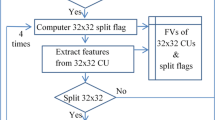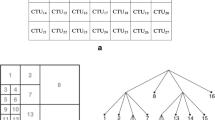Abstract
This paper proposed three feature extraction solutions suitable for detecting data embedding in motion vectors (MVs) of coded HEVC videos. In the first feature extraction solution, videos under consideration are reencoded and features are extracted from both videos from Coding Units (CUs). The difference between the two feature sets form a feature vector at a CU level. The CU level feature vectors are then summarized by computing the average and standard deviation of individual features. This summarization is computed at a frame-level and at a video sequence level. Detection models are then used to detect MV data embedding. To generate the detection models, HEVC videos are reencoded whilst employing two different data embedding solutions. Feature variables are then computed and the detection models at frame and sequence levels are generated. The second solution is an extension of an existing work that uses the concept of MV consistency for computing feature variables. In this work, we extent the MV consistency concept to HEVC coded videos by grouping sub CUs based on their coding depths. One set of features is computed by finding the joint probability that a CU has a given coding depth and the bitrate of the MV differences of the sub CUs are smaller than or equal to the between-CU MV differences. Another set of features is computed by finding a similar probability but for sub CUs with MV differences greater than the between-CU MV differences. The third solution combines the features of all of the aforementioned solutions resulting in a set of 16 feature variables. The feature variables are visualized by projecting them using spectral regression where it is shown that the third solution results in separable features. In comparison to existing work, experimental results show excellent classification accuracies for HEVC videos coded at different spatio-temporal resolutions and different bitrates.





Similar content being viewed by others
Change history
15 June 2021
A Correction to this paper has been published: https://doi.org/10.1007/s11042-021-11115-4
References
Aly HA (2011) Data hiding in motion vectors of compressed video based on their associated prediction error. IEEE Trans Inf Forensic Secur 6(1):14–18. https://doi.org/10.1109/TIFS.2010.2090520
Cai D, He X, Han J (2008) SRDA: an efficient algorithm for large scale discriminant analysis. IEEE Trans Knowl Data Eng 20(1):1–12
Fan M, Liu P, Wang H, Sun X (2016) Cross correlation feature mining for steganalysis of hash based least significant bit substitution video steganography. Telecommun Syst 63(4):523–529
J. V. Team (2003) Advanced video coding for generic audiovisual services. ITU-T Rec. H.264 and ISO/IEC 14496–10 AVC
Li B, Huang J, Shi Y (2008) Textural features based universal steganalysis. Electronic Imaging, International Society for Optics and Photonics
Li S, Deng H, Tian H, Dai Q (2014) Steganalysis of prediction mode modulated data-hiding algorithms in H.264/AVC video stream. Ann Telecommun 69(7–8):461–473
Li Z, Meng L, Xu S, Li Z, Shi Y, Liang Y (2019) A HEVC video steganalysis algorithm based on PU partition modes. Comput Mater Continua 59(2):563–574
Pevny T, Bas P, Fridrich J (2010) Steganalysis by subtractive pixel adjacency matrix. IEEE Trans Inf Forensic Secur 5(2):215–224. https://doi.org/10.1109/TIFS.2010.2045842
Shanableh T (2012a) Matrix encoding for data hiding using multilayer video coding and transcoding solutions. Signal Process Image Commun 27(9):1025–1034
Shanableh T (2012b) Data hiding in MPEG video files using multivariate regression and flexible macroblock ordering. IEEE Trans Inf Forensics Secur 7(2):455–464. https://doi.org/10.1109/TIFS.2011.2177087
Shanableh T (2013) Detection of frame deletion for digital video forensics. Digit Investig 10(4):350–360
Shanableh T (2018) Altering Split decisions of coding units for message embedding in HEVC. Multimed Tools Appl 77:8939–8953. https://doi.org/10.1007/s11042-017-4787-6
Shanableh T (2019) Data embedding in HEVC video by modifying the partitioning of coding units. IET Image Process 13(11):1909–1913
Sullivan GJ, Ohm J, Han W, Wiegand T (2012) Overview of the High Efficiency Video Coding (HEVC) Standard. IEEE Trans Circ Syst Video Technol 22(12):1649–1668. https://doi.org/10.1109/TCSVT.2012.2221191
Tabares-Soto R, Raúl R, Gustavo I (2019) Deep learning applied to steganalysis of digital images: a systematic review. IEEE Access 7:68970–68990
Tasdemir K, Kurugollu F, Sezer S (2016) Spatio-temporal rich model-based video Steganalysis on cross sections of motion vector Planes. IEEE Trans Image Process 25(7):3316–3328
Tew Y, Wong K (2014) Information hiding in HEVC standard using adaptive coding block size decision. IEEE International Conference on Image Processing, ICIP 2014, Paris, France
Wang K, Han J, Wang H (2014a) Digital video steganalysis by subtractive prediction error adjacency matrix. Multimed Tools Appl 72(1):313–330
Wang L, Wang M, Zhai L, Ren Y (2014b) H. 264/AVC video steganalysis algorithm based on motion vector abnormal correlation. Tien Tzu Hsueh Pao/Acta Electron Sin 42(8):1457–1464
Yang J, Li S (2018) An efficient information hiding method based on motion vector space encoding for HEVC. Multimed Tools Appl 77(10):11979–12001
Zarmehi N, Akhaee M (2016) Digital video steganalysis toward spread spectrum data hiding. IET Image Process 10(1):1–8
Zhai L, Wang L, Ren Y (2020) Universal detection of video steganography in multiple domains based on the consistency of motion vectors. IEEE Trans Inf Forensic Secur 15:1762–1777
Zhang H, Cao Y, Zhao X (2016) Motion vector-based video steganography with preserved local optimality. Multimed Tools Appl 75(21):13503–13519
Zhao Y, Zhang H, Cao Y, Wang P, Zhao X (2016) Video steganalysis based on intra prediction mode calibration. LNCS, Digital-Forensics and Watermarking, 14th International Workshop, vol. 9569, pp. 119–133
Author information
Authors and Affiliations
Corresponding author
Additional information
Publisher’s note
Springer Nature remains neutral with regard to jurisdictional claims in published maps and institutional affiliations.
The original online version of this article was revised: Equation 1 contains duplicate data.
Rights and permissions
About this article
Cite this article
Shanableh, T. Feature extraction and machine learning solutions for detecting motion vector data embedding in HEVC videos. Multimed Tools Appl 80, 27047–27066 (2021). https://doi.org/10.1007/s11042-020-09826-1
Received:
Revised:
Accepted:
Published:
Issue Date:
DOI: https://doi.org/10.1007/s11042-020-09826-1




